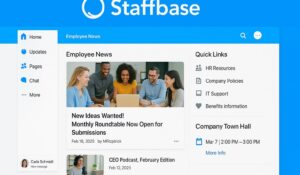Picture this: Your best employees are already recruiting for you right now. They just don’t know it yet.
Every social media post they share, professional conversation they have. Every genuine recommendation they give about your workplace. These moments represent untapped recruitment gold sitting right under your nose.
Employee advocacy means your employees are talking about your company positively – online, offline, during lunch breaks, or on LinkedIn. It’s not forced PR. It’s real stories, shared by real people, with real influence.
When done right, employee advocacy helps businesses attract top talent, improve trust in the brand, and build internal pride. Especially today, when 84% of people trust peer recommendations over advertising, employee voices carry more weight than your official campaigns.
And here’s the kicker – employees’ social networks have 561% more reach than corporate accounts. That’s power waiting to be tapped.
The numbers don’t lie. Employee advocacy works. The question isn’t whether you should implement it—it’s how fast you can get started.
Employee Advocacy = Brand Power + People Power
It’s not either/or. It’s both.
With a strong employee advocacy program, your brand looks good from the inside out. Job seekers notice. Customers trust you more. Employees feel proud.
And the best part? You don’t need a massive budget. Just the right strategy and the right platform.
st effective recruitment channel. Because in today’s competitive talent market, authenticity wins and nobody tells your story better than your own team.
What Employee Advocasy Is in the Workplace Context
In the workplace, employee advocasy is when team members willingly share positive, authentic stories about their work experience, their organization, and the products or services they help deliver. This could be posting about a successful project on LinkedIn, talking about a great company initiative with peers, or even speaking at industry events as a representative of the organization.
Unlike marketing campaigns that are crafted for a specific audience, employee advocacy content is unfiltered in a way that feels personal. According to Edelman Trust Barometer, employees are seen as the most credible source of information about a company’s work culture and values, often ranking higher than CEOs and marketing departments. This makes advocacy a powerful tool for building both brand reputation and internal morale.
In practical terms, workplace employee advocacy might involve:
- Sharing updates about corporate social responsibility projects.
- Posting about teamwork in the workplace after a big win.
- Highlighting positive feedback for employees in a public forum.
- Talking about growth opportunities and leadership support.
It is important to note that employee advocacy is voluntary. Employees must feel genuinely positive about their workplace for their advocacy to be effective. Anything that feels forced will not resonate — and in the worst case, could backfire.
The Old Approach at Work vs. the Modern Workplace Approach
Old Approach:
Traditionally, companies relied heavily on polished marketing campaigns to shape their image. Employee participation was minimal, often limited to internal newsletters or scripted testimonials. HR teams controlled the narrative, and communication was one-way — from the company to the public. This approach lacked authenticity, and over time, audiences became more skeptical of corporate messaging.
Modern Workplace Approach:
In today’s workplace, authenticity is the currency of trust. The modern approach to employee advocasy involves empowering employees to share their own stories without over-scripting them. Companies provide guidance, tools, and platforms — like an internal communication tool — but leave room for individuality. This shift acknowledges that employees are not just workers; they are brand representatives whose voices matter.
A company that adopts the modern approach also integrates advocacy into its talent acquisition strategy. Job candidates can see real employee experiences before they apply, leading to better cultural fit and reduced turnover. It also creates a ripple effect internally, as employees who feel trusted to represent the company often become more engaged in their day-to-day work.
Challenges at the Workplace When Implementing Employee Advocasy
While the benefits are clear, implementing employee advocasy in a workplace is not without challenges.
- Lack of Awareness or Understanding
Many employees do not realize they can be advocates. Without clear communication, advocacy remains limited to a few enthusiastic individuals rather than being an organization-wide effort. - Fear of Saying the Wrong Thing
Employees may hesitate to post about work, worried they might accidentally share confidential information or misrepresent the company. - Inconsistent Messaging
Without a shared understanding of key values and priorities, advocacy efforts can appear fragmented, making it harder to reinforce a consistent brand image. - No Clear Incentives
While advocacy should be voluntary, recognizing and appreciating employee contributions can encourage wider participation.
Cultural Barriers
In some organizations, hierarchical structures discourage open communication. This can make employees reluctant to share their opinions publicly.
Practical Solutions to Build a Workplace Employee Advocacy Program
Overcoming these challenges requires a structured and empathetic approach.
- Education and Training
Provide clear guidelines on what can be shared publicly, including examples of great advocacy posts. Make it easy for employees to participate by offering ready-to-use assets or templates. - Empowerment through Tools
Implement an internal communication tool that centralizes updates, resources, and recognition moments. This makes it easier for employees to find shareable content. - Recognition and Rewards
Integrate advocacy into your positive feedback for employees framework. Publicly appreciate those who represent the brand positively, whether through formal recognition programs or simple shout-outs. - Leadership Involvement
When leaders actively participate in advocacy, it sets the tone for the organization. It shows that sharing authentic workplace stories is not only accepted but encouraged. - Align Advocacy with Company Goals
Tie advocacy efforts to business objectives like talent acquisition, customer trust, or community engagement. This makes advocacy a measurable part of organizational success.
Why HubEngage is the Best Choice for Implementing Employee Advocasy
HubEngage offers a powerful, workplace-focused approach to employee advocacy that aligns perfectly with modern organizational needs. Unlike generic platforms, HubEngage is designed with both the employee and the employer in mind, creating a two-way communication channel that encourages authentic sharing.
First, HubEngage integrates advocacy seamlessly into everyday workflows. With its robust internal communication tool, employees can easily access shareable content, recognize colleagues, and post about company successes without having to navigate multiple platforms. This eliminates the friction that often prevents advocacy programs from gaining traction.
Second, HubEngage allows for personalization at scale. Different teams and locations can receive tailored content that resonates with their specific experiences, making advocacy more relevant and impactful. The platform also supports gamification, so advocacy efforts can be recognized and rewarded in ways that feel meaningful to employees. By combining communication, recognition, and engagement tools, HubEngage makes employee advocasy an organic part of the workplace culture.
Workplace Examples of Employee Advocasy in Action
- A Technology Company’s Hackathon
A mid-sized tech firm organized a 48-hour hackathon. Employees posted live updates on social media, shared behind-the-scenes photos, and highlighted teamwork in the workplace. This not only attracted attention from potential hires but also strengthened internal morale. - Retail Brand Community Engagement
A retail chain encouraged employees to share their volunteer work during a company-sponsored charity event. The posts went viral locally, enhancing the brand’s reputation as socially responsible and improving talent acquisition efforts. - Professional Services Recognition
A consulting firm built an internal recognition program where positive feedback for employees could be shared publicly, encouraging advocacy while boosting morale.
The Organizational Impact of Employee Advocasy
When implemented well, employee advocasy creates measurable benefits for organizations:
- Higher Retention Rates: Employees who feel proud of where they work are more likely to stay.
- Stronger Recruitment: Advocacy improves employer branding, making recruitment efforts more effective.
- Better Workplace Culture: Advocacy promotes transparency and celebrates achievements.
- Increased Trust with Clients: When clients see employees speaking positively, it reinforces trust in the brand.
According to Gallup, engaged employees are 23% more profitable, and advocacy plays a key role in driving that engagement.
Old Employer Branding Methods vs. Advocacy-Driven Branding
Old Method:
Employer branding was top-down, controlled by marketing and HR. Limited channels were used, and employee voices were often filtered or scripted.
Advocacy-Driven Method:
Branding is bottom-up and authentic. Employees contribute in real time, using their own channels, often reaching audiences that the company could never access directly. This method is more adaptable, as employees can respond to events and news in ways that keep the brand relevant.
Key Takeaway: Making Employee Advocasy a Workplace Priority
Employee advocasy is no longer an optional HR initiative — it is a workplace priority that impacts everything from talent acquisition to retention, culture, and brand trust. In an era where authenticity is everything, organizations must equip employees with the right tools, encouragement, and recognition to share their workplace stories.
HubEngage offers the ideal platform to turn advocacy into a sustainable strategy. With its ability to integrate communication, recognition, and engagement in one place, it ensures that every employee has both the means and the motivation to become a brand advocate.
If you want to build a workplace culture where advocacy is natural, effective, and measurable, it is time to make HubEngage your partner in this journey. Connect with us today and see how your employees can become your strongest brand ambassadors.













